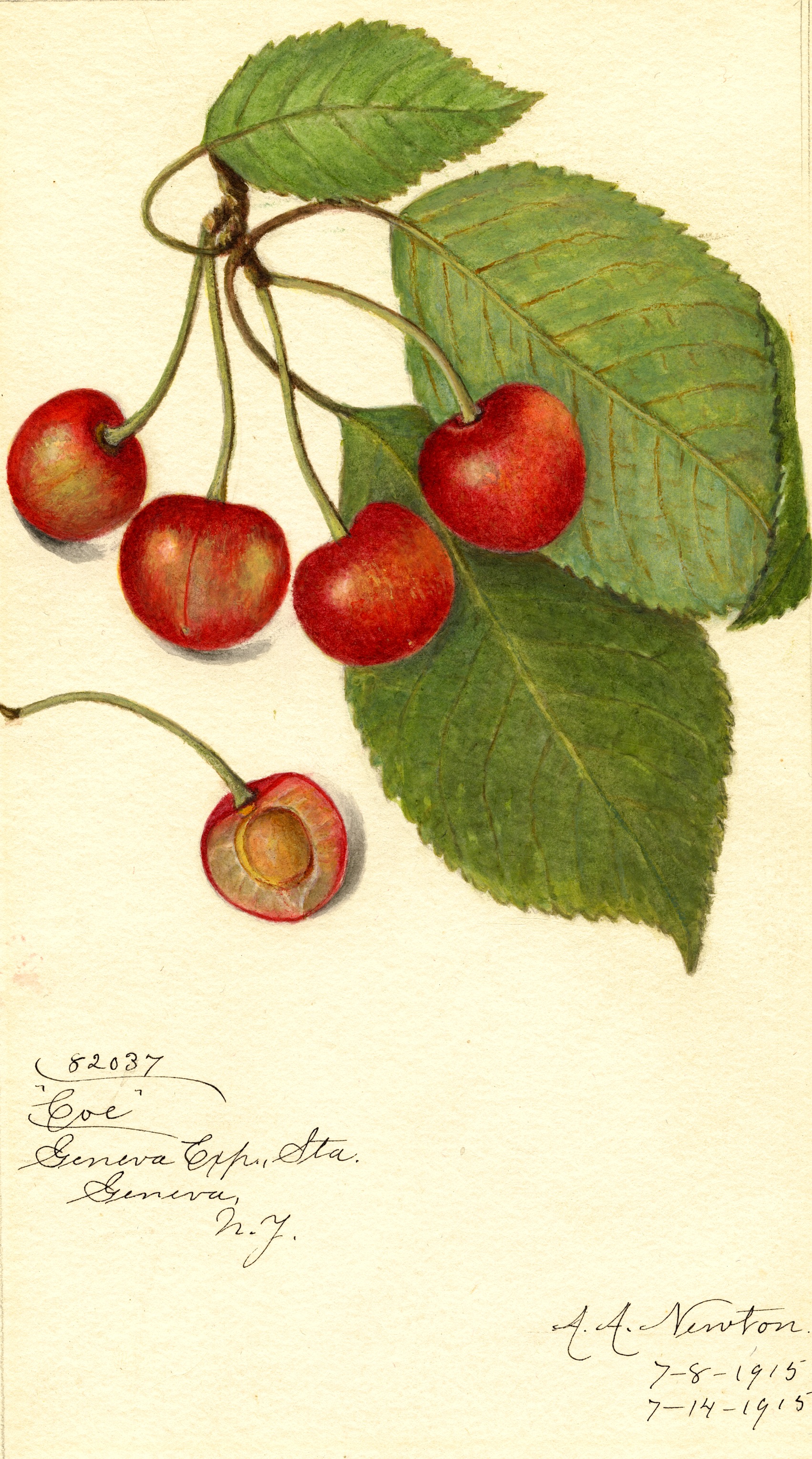 COE’S TRANSPARENT
COE’S TRANSPARENT
The second American-bred cherry (after Downer’s Late) to secure a national following, the Coe’s Transparent was a seedling of the Ox Heart discovered by Curtis Coe of Middletown, Connecticut in the early 1840s. Its round semi-translucent fruit were smallish, beautiful, and flavorsome. Yet its greatest recommendation was its early time of maturation, coming ripe some days before the Black Tartarian. In 1847 the editor of The Horticulturist and Journal of Rural Art and Taste visited Coe to examine the famous cherry. The editor described the fruit thusly: “Fruit of medium size, remarkable round and regular in form, considerably resembling that of a duke cherry. Skin thin, wax-like, of a very delicate, pale amber, nearly covered with pale cornelian red in the sun, and marked with delicate pal spots or blotches, which give it an unique appearance . . . . “Flesh very tender, melting and juicy, with a delicate but sweet and excellent flavor.” [“Coe’s Transparent Cherry,” Horticulturist 2, 2, (August 1847), 71.] An antebellum judgment of medium size would seem small in the 21st century. They were grown extensively in Maryland, Virginia, Kentucky, and North Carolina. The USDA maintains two strains of the Coe’s Transparent, http://www.ars-grin.gov/cgi-bin/npgs/acc/display.pl?1684582 and the variety is available at several American nurseries: Rolling River Nursery [USDA Organic]https://www.rollingrivernursery.com/products/1058/16/fruit-trees/cherries-prunus-avium/coes-transparent-sweet-cherry-detail One Green World https://www.onegreenworld.com/Cherry/Coe39sTransparent/3379/ Arboreum Company https://www.arboreumco.com/store/products/coes-transparent .
“Fruit of medium size, remarkable round and regular in form, considerably resembling that of a duke cherry. Skin thin, wax-like, of a very delicate, pale amber, nearly covered with pale cornelian red in the sun, and marked with delicate pale spots or blotches, which give it an unique appearance.” [“Coe’s Transparent Cherry,” Horticulturist 2, 2, (August 1847), 71.] The tree is large and spreading, noteworthy for “hardiness, vigor, healthfulness, and fruitfulness.” Ulysses Hedrick, Cyclopedia of Hardy Fruits (New York, 1922), 140.
Nursuries that offered Coe's Transparent prior to 1920:
Atlanta Nurseries, Atlanta, GA 1895. Bluegrass Nursery, Lexington, KY 1891. Cedar Cover Nurseries & Orchard, Salem, NC 1893. Downer Nursery, Fairview, KY 1870. Frederick Nursery, Frederick, MD 1897. Fruitlands, Augusta, GA 1885-1899. Garvin Nursery, Wheeling, WV 1895. Greensboro Nursery, Greensboro, NC 1910. Guilford Nurseries, Vandalia, NC 1897. Hopewell, Nursery, Fredericksburg, VA 1859. Huntsville Nursery, Huntsville, AL 1892. Kentucky Nursery, Louisville, KY 1897. Milford Nursery, Milford, DE 1890. Munson Hill Nursery, Falls Church, VA 1897-1908. Old Dominion Nursery, Richmond, VA 1902-1907. Pomaria Nursery, Pomaria, SC 1856. Richmond Commercial Nursery, Richmond, VA 1897. Silver Leaf Nurseries, Booen's Path, VA 1888. Staunton Nursery, Staunton, VA 1858. Van Lindley Nursery, Pomona, NC 1899-1908.
Image: U.S. Department of Agriculture Pomological Watercolor Collection. Rare and Special Collections, National Agricultural Library, Beltsville, MD 20705, Amanda Newton, 1915.
David S. Shields